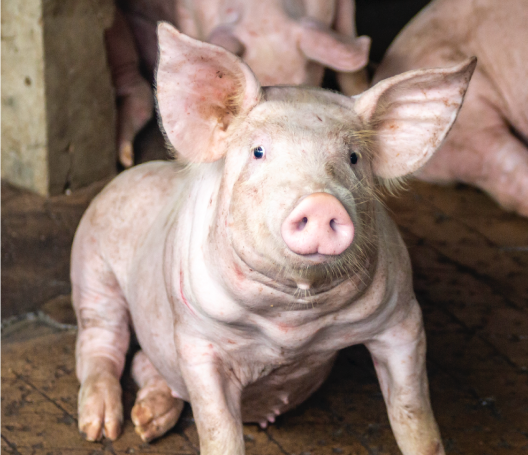Erysipelas – Parvovirosis – Leptospirosis
Control and prevention of these 3 pathogens are key to ensure good reproductive performance in breeding herds worldwide.

Erysipelas
Disease
Erysipelas, caused by the bacterium Erysipelothrix rhusiopathiae (E. rhusiopathiae), together with parvovirosis and leptospirosis, is one of the main infectious causes of reproductive loss in swine.
During pregnancy it may result in severe reproductive failure. Therefore, control and prevention of diseases associated to this swine pathogen is key to ensure good reproductive performance in breeding herds.
Erysipelas can be seen in all age groups of pigs, although adults and growing pigs above 12 weeks of age are more commonly affected. Erysipelas is usually associated with skin lesions and arthritis, but in sows can also cause reproductive symptoms such as infertility, abortion, and increased numbers of mummified foetuses and stillbirths.

Economic impact
Erysipelas accounted for >37% of causes of whole carcass condemnations in a pig slaughterhouse in Tuscany (Italy).1
In the UK, it was estimated that a 400-sow breeding herd with an acute Erysipelas outbreak could lose 388 pigs due to abortions and sow mortality. For 2008, this would have cost £14,000.
Chronic Erysipelas in a 600-head finisher herd from the UK could result in 58 pigs being euthanized and 31 condemned for a total loss of £17,451 over a six-month period.

1. Guardone L, et al. A Retrospective Study after 10 Years (2010-2019) of Meat Inspection Activity in a Domestic Swine Abattoir in Tuscany: The Slaughterhouse as an Epidemiological Observatory. Animals (Basel). 2020

Prevalence
Erysipelas is worldwide distributed and ubiquitous.
It is estimated that approximately 30-50% of healthy pigs carry E. rhusiopathiae.

Diagnosis
E. rhusiopathiae is known to cause three main clinical manifestations in animals: acute, subacute, and a chronic disease.
- In sows, onset of acute erysipelas can be sudden, resulting in an increase in abortions, stillbirths, lameness, and even death due to generalized infection or septicaemia.
- In growing pigs, the acute form is characterized by typical rhomboid (diamond-shaped), urticarial skin lesions and fever, whereas the chronic form is characterized by arthritis.
Key points to recognize erysipelas:
- High fever (41 to 42 ºC), usually without respiratory signs or diarrhea.
- Discrete, raised, and red to purple areas of skin, usually with a rhomboid or diamond shape.
- Swollen joints and lameness (pain in the legs: stilted, stiff movement, arched back line).
- Piglet sudden death.
- Infertility, irregular returns to oestrus, abortions, increased numbers of mummies and stillbirths, and small litters.
- Endocarditis (growths on the valves inside the heart).
When fresh foetal tissues are available, detection of E. rhusiopathiae by PCR is the test of choice, as a positive result is highly indicative of ER being the root cause.

Treatment and prevention
Control and prevention of erysipelas are key to ensure good reproductive performance in breeding herds. Control measures should include strict biosecurity, hygiene protocols, vaccination and medication when needed.
Prevention solutions should be prioritized to limit the use of antibiotics and therefore, the risks of antibiotic resistance.
- Biosecurity, including strict rodent and bird control programs to minimize infection from other animal species, as rodents can be carriers of E. rhusiopathiae.
- Hygiene, including cleaning and disinfection protocols of all buildings/rooms between batches of pigs. This is especially important for E. rhusiopathiae, as it can remain infectious for long time periods, and contaminated instruments or stables may therefore be a constant source of infection.
- Vaccination, to improve immunity and reduce disease prevalence. It helps protect the animals’ health, reproductive performance and farm productivity. Once the vaccine has been introduced, it is recommended to use it regularly in all the sows and gilts on the farm, therefore minimizing the possibility of transmission.
- Medication, if a Erysipelas outbreak occurs. Antimicrobials are usually effective controlling clinical signs, although they do not eliminate infection completely.
No herd, irrespective of its health status, is likely to be free of E. rhusiopathiae infection and therefore eradication is not possible or very unlikely.
Erysipelas is a contagious disease of swine and many other animal species, including humans. Therefore, it is a potential occupational zoonosis with public health implications.
Download the disease infographic
MSD Animal Health solutions to control Erysipelas – Parvovirosis – Leptospirosis

SowCare: Porcilis® Ery+Parvo+Lepto
Porcilis® Ery+Parvo+Lepto is an inactivated vaccine against Porcine parvovirus, Erysipelas disease and Leptospira.
SOLUTIONS
Porcilis® Ery+Parvo+Lepto
Inactivated vaccine against Porcine Parvovirus,
Erysipelas disease and Leptospira.


Onset of immunity after vaccination:
E. rhusiopathiae: 3 weeks
Porcine Parvovirus: 10 weeks
Leptospira serogroups: 2 weeks
Duration of immunity:
E. rhusiopathiae: 6 months
Porcine Parvovirus: 12 months
Leptospira serogroups Australis: 2 weeks
Leptospira serogroups Canicola, Icterohaemorrhagiae, Grippotyphosa, Pomona and Tarassovi: 12 months
BENEFITS
- The broadest protection against Leptospira.a
- The longest combined protection for the 3 pathogens.
- Excellent safety profileb
- Can be used during pregnancy.c
HOW TO USE IT
- For intramuscular use.
- Administer a single dose of 2 ml in the neck region.
Available in EU, APSA and LATAM
Porcilis® Ery+Parvo+Lepto can be used in mass vaccination.
a. Jacobs, A.A.C., et al. (2015). A novel octavalent combined erysipelas, parvo and Leptospira vaccine provides (cross) protection against infection following challenge of pigs with 9 different Leptospira interrogans serovars. Porcine Health Management 1:16 pp 1-7.
b. Jacobs, A.A.C., et al. (2015). Safety and efficacy of a new octavalent combined erysipelas, parvo and Leptospira vaccine in gilts against L. interrogans serovar Pomona associated disease and foetal death. Vaccine 33 pp 3963-3969.
c. Porcilis® Ery+Parvo+Lepto SPC

SowCare:
Other related vaccines
Porcilis® Ery+Parvo
Porcilis® Ery
Porcilis® Parvo



